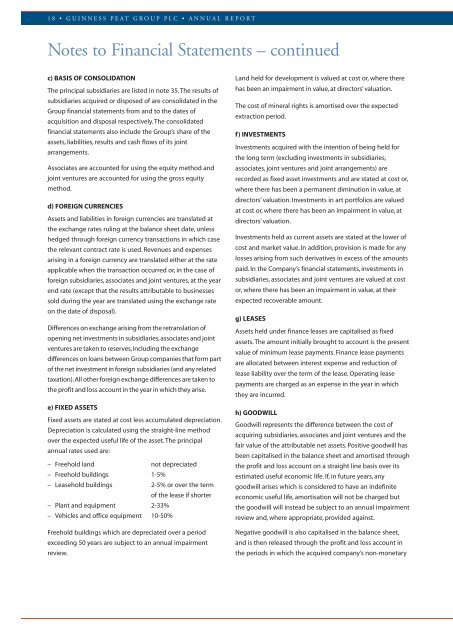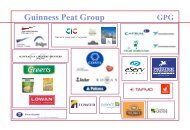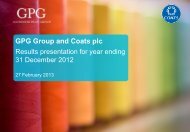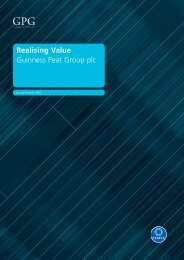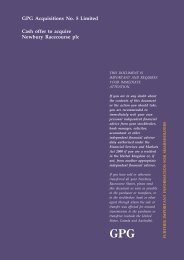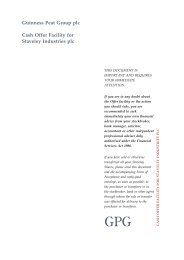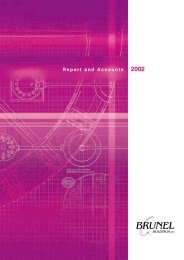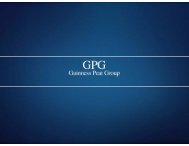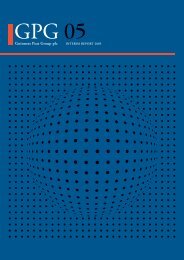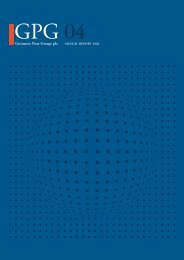GPG Report & Accounts 2003 - Guinness Peat Group plc
GPG Report & Accounts 2003 - Guinness Peat Group plc
GPG Report & Accounts 2003 - Guinness Peat Group plc
- No tags were found...
You also want an ePaper? Increase the reach of your titles
YUMPU automatically turns print PDFs into web optimized ePapers that Google loves.
18 • GUINNESS PEAT GROUP PLC • ANNUAL REPORTNotes to Financial Statements – continuedc) BASIS OF CONSOLIDATIONThe principal subsidiaries are listed in note 35. The results ofsubsidiaries acquired or disposed of are consolidated in the<strong>Group</strong> financial statements from and to the dates ofacquisition and disposal respectively. The consolidatedfinancial statements also include the <strong>Group</strong>’s share of theassets, liabilities, results and cash flows of its jointarrangements.Associates are accounted for using the equity method andjoint ventures are accounted for using the gross equitymethod.d) FOREIGN CURRENCIESAssets and liabilities in foreign currencies are translated atthe exchange rates ruling at the balance sheet date, unlesshedged through foreign currency transactions in which casethe relevant contract rate is used. Revenues and expensesarising in a foreign currency are translated either at the rateapplicable when the transaction occurred or, in the case offoreign subsidiaries, associates and joint ventures, at the yearend rate (except that the results attributable to businessessold during the year are translated using the exchange rateon the date of disposal).Differences on exchange arising from the retranslation ofopening net investments in subsidiaries,associates and jointventures are taken to reserves,including the exchangedifferences on loans between <strong>Group</strong> companies that form partof the net investment in foreign subsidiaries (and any relatedtaxation).All other foreign exchange differences are taken tothe profit and loss account in the year in which they arise.e) FIXED ASSETSFixed assets are stated at cost less accumulated depreciation.Depreciation is calculated using the straight-line methodover the expected useful life of the asset. The principalannual rates used are:– Freehold land not depreciated– Freehold buildings 1-5%– Leasehold buildings 2-5% or over the termof the lease if shorter– Plant and equipment 2-33%– Vehicles and office equipment 10-50%Freehold buildings which are depreciated over a periodexceeding 50 years are subject to an annual impairmentreview.Land held for development is valued at cost or, where therehas been an impairment in value, at directors’ valuation.The cost of mineral rights is amortised over the expectedextraction period.f) INVESTMENTSInvestments acquired with the intention of being held forthe long term (excluding investments in subsidiaries,associates, joint ventures and joint arrangements) arerecorded as fixed asset investments and are stated at cost or,where there has been a permanent diminution in value, atdirectors’ valuation. Investments in art portfolios are valuedat cost or, where there has been an impairment in value, atdirectors’ valuation.Investments held as current assets are stated at the lower ofcost and market value. In addition, provision is made for anylosses arising from such derivatives in excess of the amountspaid. In the Company’s financial statements, investments insubsidiaries, associates and joint ventures are valued at costor, where there has been an impairment in value, at theirexpected recoverable amount.g) LEASESAssets held under finance leases are capitalised as fixedassets. The amount initially brought to account is the presentvalue of minimum lease payments. Finance lease paymentsare allocated between interest expense and reduction oflease liability over the term of the lease. Operating leasepayments are charged as an expense in the year in whichthey are incurred.h) GOODWILLGoodwill represents the difference between the cost ofacquiring subsidiaries, associates and joint ventures and thefair value of the attributable net assets. Positive goodwill hasbeen capitalised in the balance sheet and amortised throughthe profit and loss account on a straight line basis over itsestimated useful economic life. If, in future years, anygoodwill arises which is considered to have an indefiniteeconomic useful life, amortisation will not be charged butthe goodwill will instead be subject to an annual impairmentreview and, where appropriate, provided against.Negative goodwill is also capitalised in the balance sheet,and is then released through the profit and loss account inthe periods in which the acquired company’s non-monetary


